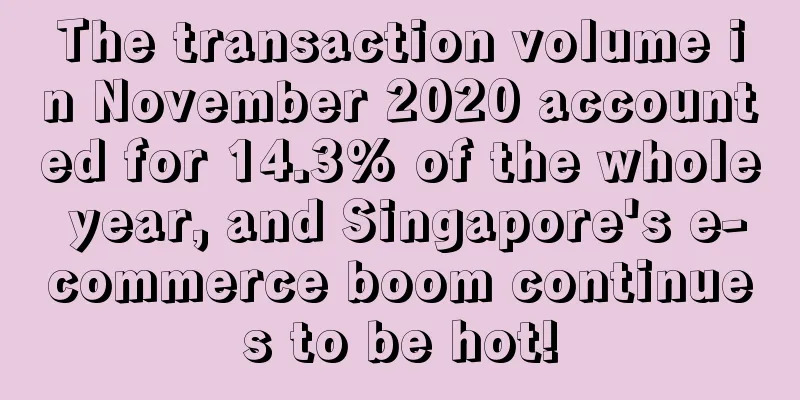Dong Haiwen: Can white hat tactics save your Amazon business? The underlying logic of A9 algorithm SEO can help you out!

|
Hello, students! I am Dong Haiwen, and everyone is used to calling me Teacher Dong. This is the second article I wrote. (I wrote the first article about the 60 pitfalls that Amazon often falls into. Many students told me that they have fallen into many of these pitfalls, and some are still falling into them. Students who are interested can search and read "Dong Haiwen: Companies that failed on Amazon: Talking about the six aspects of people, finance, production, supply, sales, and materials, and avoid falling into pitfalls!") The topic of white hat is gradually getting hot. Since I started doing Amazon training in 2016, I have been advocating white hat methods for Amazon compliance operations. This year, I finally have the opportunity to write such an article to share with you and discuss the underlying logic of Amazon A9 algorithm and SEO. By the way, I also answer the question asked by many sellers from this perspective: "Is white hat method feasible?" During Amazon's bonus period in the early years, not only was the competition less intense than that of domestic e-commerce, but the Amazon platform policies were not very strict. Many sellers followed their usual practice of receiving dozens or even hundreds of orders as soon as their products were launched, and their sales quickly increased. Some sellers even exploited loopholes in the platform rules to quickly sell their products. Now that Amazon's platform policy has changed, it has become even more severe for "illegal" sellers and stores, with a series of account closures, brand closures, fund closures, and multi-site joint punishments... After the "Wu Sangui" and "Zhang Sanfeng", many sellers are now left with "Li Siguang", with only comments, traffic, funds and hair, which makes sellers return to the pre-liberation era overnight. 2021 and 2022 are also the years with the most severe crackdowns since Amazon officially invited Chinese sellers to join in 2014. According to the current Amazon policies and trends, this year's account blocking and severe crackdowns have become "normalized" in the future, and even more stringent. Having said that, the platform has also made principled policy changes for factors such as buyers' purchasing experience, reshuffled the cards for Chinese sellers, created a fair market environment for sellers that truly operate in compliance with regulations, and created a better shopping environment for platform buyers and users. This is a good opportunity for sellers who have always advocated white hat tactics and long-termism. Similarly, for sellers who need to continue operating on Amazon and plan to transform to a white-hat, long-term approach, this is also a good direction and time point for thinking about corporate transformation. Besides, how can they hide their shua-order and black-tech tricks from the world’s top technology companies, especially when these talents are all top students from Harvard and Yale Universities? So can orthodox white hat tactics save your Amazon business in the long run? The answer is yes! Some sellers may still be questioning: How can there be reviews without shua orders? How can you survive without reviews? If you disagree or it is beyond your understanding, you might as well expand your own seller circle. Similar to our circle, many sellers have never done shua orders or black technology, but they have become the top. In their words, white hat operation is "a way that allows Amazon people to sleep at night." 01 The underlying principle of Amazon's e-commerce "traffic pool" When operating on the Amazon platform, whether you are building a brand or seeking profits, you must first have sales, and the eternal formula for e-commerce sales is: Image source: Cross-border e-commerce excellent craftsman school In this formula, the average order value is determined by oneself, and the conversion rate has its own ceiling. It is impossible to achieve 100% for a long time, and even 50% is difficult (the platform has big data statistics for a certain category, and if the conversion rate exceeds a certain amount for a long time, the platform will check or suppress the weight of the link). Moreover, there are many factors that affect the conversion rate, and reviews are not the main one. For example, since the price involution this year, the prices of many categories of products are more sensitive to conversion rates than reviews. Then the most important factor to break through sales volume is the traffic pool. For example: Amazon's subcategory ranking is measured by sales volume. For example, Product A is already the No. 1 Best Seller in the subcategory, and Product B is ranked second in the subcategory. The conversion rate of Product A is 7% higher than that of Product B. Assuming that the traffic of Product B exceeds 7%, then the sales volume of Product B will surpass that of Product A and become the new Best Seller. The size of the traffic pool for each product category is determined by buyer demand. No matter how Amazon closes stores, buyer traffic will not be lost, and the demand for many product categories is even growing. Regardless of whether it is a traffic-concentrated or dispersed product, as competition becomes increasingly fierce and there is a wide variety of products, buyers who want to quickly find products with certain attribute characteristics have to search for keywords that are a combination of product core words + attribute words to quickly find the products they want. For example, if a buyer wants to find a thin and light power bank with a capacity of 2000mAh, he can only search for "power bank 2000mah" to quickly find the product he wants. If he uses the core word "power bank" to search, as shown in the figure below, all products are large-capacity products. Image source: Amazon backend screenshot There are many keywords like this that meet the needs of buyers (plus there are even more search terms combined with different search habits of buyers), and these words are highly accurate and have good conversion rates. Therefore, I proposed a strategy to break through the traffic pool of competing products - the "Maginot Line". Image source: Cross-border e-commerce excellent craftsman school Today, I would like to share with you the differences between my “Maginot Line” massive keyword SEO strategy and the old extensive link strategy of the past. In the early days when competition in the category was not fierce, many seller operations staff would copy the copy of the top few competitors’ products in BSR and write their own copy after getting new products. There was no way to judge the quality of the listing after it was published, or whether Amazon had captured accurate information or a large number of included words before shipping the products. After the products were put into the warehouse and put on sale, they would just use a few or dozens of big traffic keywords to advertise, such as “I’ll Love You Until I Die”. Otherwise, it seemed impossible to increase sales. It is not enough to advertise with big keywords, so you have to fake some orders, or even use black technology to manipulate keyword rankings, etc. As a result, the cost of big keyword advertising is high and Acos cannot control it. There is also a great risk of shua orders to manipulate comments and keyword rankings. Image source: Cross-border e-commerce excellent craftsman school Most of the product links created with such "aggressive operations" have a common feature, that is, they are driven by big words and dominated by advertisements. Once the ranking of big words drops, sales will drop sharply (as everyone knows, the cost of raising and stabilizing the ranking of big words is not small), and most operators don't know why or why they are defeated. My approach is different. First, I use tools to capture a large amount of keyword data of competitors, and classify them into positive and negative words. Positive words are used to write copy, and the keyword layout of the copy is done well. After the copy is published, I use my "four accuracy and two more" to judge whether Amazon has captured our listing information accurately and how many keywords are included. If it meets the requirements, I will make an FBA order and ship it. After the listing is online and available for sale, I will check which words are included and ranked by Amazon for the second time. I will use advertising and compliance strategies to push more words into the first three pages, then to the homepage, and then to the top position of the homepage. Finally, I use methods to increase conversion rates to gradually stabilize the keyword rankings. In this way, the stability of the listing is very high, and the overall sales will not be unstable due to reliance on a certain big word or because of the instability of some big words. 02Breakthrough in keyword operation means breaking through Amazon’s 80% traffic pool Now that we understand the principle of Amazon e-commerce traffic pool, how can we create a listing traffic pool to break through the sales barrier? ——The entrance to the Amazon platform traffic pool. Image source: Cross-border e-commerce excellent craftsman school Amazon's on-site traffic is divided into eight major ports, of which search, advertising, and association account for 80% of the entire Amazon traffic. The carriers of these three traffic ports are keywords. In other words, keywords are the entrance to Amazon's on-site traffic. Breaking through keyword operations can break through nearly 80% of Amazon's on-site traffic pool. Based on my nearly 10 years of continuous tracking and testing of Amazon A9 algorithm and Amazon search engine optimization (SEO), I have developed a complete set of pure white hat operation systems, which I call the "Dong-style flywheel principle." Image source: Cross-border e-commerce excellent craftsman school The "Dong-style flywheel principle" has a total of 5 rollers. The keyword system is the first roller, which consolidates the listing chassis. The keyword layout to the copy drives the second roller, allowing the Amazon system to accurately collect and identify the listing information. With Amazon's collection and recognition of listing information, we can use advertising as a driving force to accurately deliver and continuously expand the precise traffic pool that meets the buyer's purchasing behavior, so as to achieve natural keyword rankings from the first three pages to the homepage, and from the homepage to the top of the homepage. At the same time, driven by increasing sales, Amazon will recognize the listing performance again. The better the performance, the greater the weight Amazon assigns. The greater the listing weight, which in turn will drive the advertising effect (the better the advertising effect, the lower the bid value) and the expansion of keyword collection. At this time, the increasing rhythm of advertising and sales is controlled and adjusted through operational data. The five roller gear transmission can make the proportion of natural orders of listings reach 95% or even 100%, which does not rely on advertising. The weight of listings is stable and long-term. The benefits of natural keyword ranking on the homepage: it can solve the problem of free traffic, break through the proportion of natural orders, and avoid high-cost passive operation of advertising. 03 Amazon's SEO underlying logic for crawling listings (Dong-style flywheel principle "keywords and copywriting" layout) The search engine optimization (SEO) of e-commerce platforms relies on algorithms, and Amazon is no exception. The underlying logic of every Amazon search result page is "A9". Amazon A9 displays the most relevant product list on the page based on the buyer's search keyword attributes. Keywords are the carrier of Amazon's search engine optimization (SEO) and are also a demand search by buyers. Therefore, in addition to adding product-related attribute keywords to the listing copy for SEO layout, we also need to know how to determine whether the listing is included. After the listing is published, it will be displayed on the Amazon front desk for 15 minutes. This 15 minutes is the first time Amazon crawls your listing information, which is called static inclusion. This inclusion is extremely important. There must be a way to ensure that the Amazon system captures your listing’s included keywords accurately and with a large number of included words. If the captured keyword information is not accurate, when the product is launched (in saleable status) and automatic advertising/manual advertising (broad and phrase matching) is run, a large number of irrelevant words will be attracted. The scary thing is that these irrelevant words will not only cost you a lot of advertising fees, but also these irrelevant words will be included and even more irrelevant keywords will be extended. The operators will waste a lot of time every day to deny the junk words that come out of this or that advertisement. So how can we make the Amazon system statically capture our listings accurately and with a wide range of vocabulary? First of all, after posting the copy and before making an FBA order, you need to determine the accurate and extensive keyword information statically included in the listing. If it meets the standards, then make an FBA order and ship it (my method can achieve the data quantification standards for static collection of products in each category). If it does not meet the standards, delete the link (not yet shipped) and re-post until it meets the standards (those who know the method can meet the standards quickly). This operational step is extremely important! The so-called A9 and the underlying logic of Amazon's search engine optimization (SEO) do not have a solid foundation, and the keywords that are dynamically included later cannot come up (the information captured by Amazon through buyer searches or other clicks is called dynamic inclusion). From the logic of the "Dong-style flywheel principle", it can be seen that the most basic operation of Amazon's operations is to do a good job of keywords and capture more and more accurate vocabulary. With accurate vocabulary laid out in the copy, there will be natural ranking only if it is included. Many people may question: There are limited characters for copy titles, ST, five elements and A+ product descriptions, so where do so many key words come from? Let me share with you that the keyword information captured by the Amazon system is word roots. For example, the keyword power bank is presented as #power and #bank in the Amazon index library. Amazon A9 captures word roots based on the different weights of keyword information such as title, ST, five elements and A+ product description. The captured word roots will be matched and combined by the Amazon system into a variety of keywords, thus forming a massive keyword thesaurus, which is called "spider web relationship" in Internet professional terminology. Image source: Cross-border e-commerce excellent craftsman school From the root combination keywords statically included in the copy to the keywords associated with the buyer's search keywords, the continuous expansion of the keywords included in the listing has formed a massive keyword traffic entrance. 04 The purpose of advertising is not to advertise (Dong-style flywheel principle "advertising method" power-assisted bicycle) In my "Dong-style flywheel principle" logic and strategy, advertising is only a keyword operation promoter. When a large number of your keywords are naturally ranked and the natural order proportion is large, the advertising budget will begin to decline slowly, or even be stopped. If the proportion of orders from advertising is large, suddenly pausing the advertising or reducing the budget, the poor performance of the advertising on that day may even lead to a decrease in organic orders (the organic ranking of keywords will decline). This is also a situation that many people are facing now, and the problem lies in the proportion of organic orders. The logic behind the purpose of advertising is not to advertise or to advertise less is as follows, as shown in the figure below. "Regularization" is the balance point between natural orders and advertising orders . The length of this balance point depends on the natural ranking of your keywords and the growth in natural order volume. Image source: Cross-border e-commerce excellent craftsman school As we all know, the CPC cost of advertising is getting higher and higher. For many seller companies, advertising expenses accounted for about 2-4% of sales in 2016-2017, about 5-7% in 2018-2019, and 8-10% in 2020. In 2021 and 2022, many sellers will definitely account for more than 10% throughout the year. In addition, many people are afraid to make shua orders this year and will put more operating costs into advertising. The CPC will rise again, which may be more than 3 points higher than my forecast of 10%. The proportion will be even higher next year. How much profit will our products have in this case! 05 A9 algorithm quantitative thinking controls the operation rhythm (Dong-style flywheel principle "incremental volume and operation data" to protect the city) Let’s look back at the “Dong’s Flywheel Principle”. Sales volume is a yardstick that Amazon uses to measure the performance of a listing, and the scale of this yardstick is the incremental sales volume, which is a major determining factor in Amazon’s A9 algorithm. When sales are stable and the daily average growth of sales is ensured in a certain period, the weight assignment of Amazon A9 algorithm will be stimulated (but sales are not manipulated by artificial shua orders and evaluations. Amazon monitors the quality of buyer accounts, and poor quality is the opposite). The greater the value assigned to the listing weight, the more traffic support will be given by the Amazon system diversion mechanism. Image source: Cross-border e-commerce excellent craftsman school Secondly, data analysis is an essential operation for e-commerce, and operational data is by no means as simple as the data from Amazon's backend or certain ERP tools. Refined operational data can provide sufficient basis for you to judge your daily temporary or long-term operational adjustment plans. With years of experience in operations and data tracking and judgment, I have summarized 30 dimensions of Amazon operations data tracking. The more detailed the data is, the more likely it is to find problems and solve them quantitatively. For example, if there are 100 visits today, how many of these 100 visits come from natural traffic? These natural traffics determine which keywords generate clicks, and so on. Image source: Cross-border e-commerce excellent craftsman school Screenshot of operational data cases; organic orders accounted for 94.34%, advertising orders accounted for 5.66%, advertising expenditure accounted for 6.5% of sales, and listing accuracy was 73.79%. In short, with multi-dimensional operational data tracking, firstly, operational personnel can be given timely operational adjustments; secondly, the dimensions of operational compliance can be quantified; thirdly, assessment indicators can be quantified; fourthly, it can be clearly understood how the product became popular; and fifthly, the details of operational strategies can be quantified for replicable delivery. 06Case Studies and Interpretations Image source: Cross-border e-commerce excellent craftsman school Image source: Cross-border e-commerce excellent craftsman school The key to the rapid success of the product in this case lies in the gradual increase in the proportion of natural orders and the continuous expansion of the traffic pool. This is because Amazon search engine optimization (SEO) was used well to do a good job in keyword layout, and the FBA order was made and shipped only after the copywriting test achieved "two accurate and two more". In addition, among the 11,601 positive vocabulary (precisely related words), 427 words were on the homepage on the first day of the launch, and the copywriting successfully laid the foundation. In addition, the rhythm of keyword inclusion and ranking was well controlled, and the dynamic inclusion of words was quickly extended. On the 18th day , 5,904 words were on the homepage (accounting for 50.89% of the positive vocabulary), and the 7-day flash sale qualification was obtained on the 18th day, and the small category BSR ranking was obtained on the 17th day. 07 I have what others don’t, and I am better than others (Refine the conversion rate) Although there is a ceiling for conversion rate and it is difficult for a single product to always achieve 100%, the conversion rate is also very important. There are many factors that affect conversion rate, and comments do not 100% affect conversion rate. I have summarized 61 dimensions of factors that affect conversion rate, divided into external and internal factors, and listed them as follows: Image source: Cross-border e-commerce excellent craftsman school Many sellers previously believed that “conversion rate is everything”. In fact, Amazon has big data statistics on the conversion rate of each category of products. Many sellers in different categories have relatively high product conversion rates, but they also found that the traffic pool has certain limitations, and it is difficult to break through the bottleneck at a certain stage. Refined operation is an operating method that achieves a very detailed conversion rate, which can achieve "what others do not have, I have, and what others have, I have better", just like a picture, a video, and an A+ page are all done to the extreme, expressing the buyer's impulses and demand pain points vividly. Conversion rate is one of the important factors in the A9 algorithm and the most core element for stabilizing keyword rankings. However, if the conversion rate is higher than Amazon's big data conversion rate for the product category for a certain period of time, Amazon will suppress the expansion of your traffic pool; for example, as shown in the example below, the conversion rate is 100%, but the traffic bottleneck comes, and many words are not included and ranked. Image source: Cross-border e-commerce excellent craftsman school We don't have to blindly pursue overly extreme conversion rates. Conversion rates are not measured or determined by a single dimension (such as reviews), but are determined by buyers through a combination of multiple dimensions. Therefore, I advocate that conversion rates should be refined in details, "I have what others don't, and I am better than others." If the risks of operating on Amazon far outweigh the benefits, you might as well step out of your original comfort zone (but starting this year, this comfort zone is no longer comfortable), make more friends with white hat tactics, and learn new compliant white hat operation methods with an empty cup mentality. Perhaps only in this way can you continue to have the confidence and sense of direction to continue operating. The above is provided for your reference. The future is unknown, but what is known is that Amazon’s closure of stores, brands and funds has become a normal practice. News like “so-and-so’s super seller account has been blocked again” is no longer surprising, and sellers’ behavior has become more disciplined. No matter what the platform rules are, it is a start for those who are determined to operate in the long term! Operate in compliance and reasonably, and sleep well! Finally, I wish all the sellers all the best, smooth, happy, and smooth sailing! At the same time, if it helps you, please forward and share it. Thank you for your patience in reading it. |
<<: Shenzhen’s top seller’s annual revenue exceeds 4 billion!
Recommend
Amazon's order cancellation process has changed, and sellers complain that it has become more complicated!
According to an announcement from Amazon US, star...
Amazon officially responded to the suspension of the authorized brand project
In the early morning of November 17, sellers who ...
Spoiler alert! Wish will tell you the key categories and traffic directions for next year!
Now, it’s officially Wish’s “summit moment”! Wish...
South Korea will strengthen supervision of e-commerce business to protect consumer rights
It is reported that after the Fair Trade Commissi...
What is VNLIN Middle East e-commerce logistics? VNLIN Middle East e-commerce logistics Review, Features
Vnlin Middle East E-commerce Logistics is a leadin...
What is CB CONNECT Brazil Warehouse (Shanghai Yichuan)? CB CONNECT Brazil Warehouse (Shanghai Yichuan) Review, Features
CB CONNECT Brazil Warehouse is a company specializ...
What is SAKTOK? SAKTOK Review, Features
SAKTOK is a professional organization in Shenzhen ...
Expected to spend 60 billion pounds! Britain is about to usher in a shopping boom after the lockdown
According to foreign media reports, as the UK gra...
Alibaba's globalization is steadily advancing, and Lazada's quarterly orders continue to achieve triple-digit year-on-year growth
On February 2, Alibaba released its third-quarter...
Less than 4 months after listing, the "hot-selling trader" issued a profit warning!
Some say that the era of cross-border expansion i...
What is ALLINPAY? ALLINPAY Review, Features
Tonglian Payment (Tonglian Payment Network Service...
What is Fuyou Payment? Fuyou Payment Review, Features
Fuyou Payment (Shanghai Fuyou Payment Services Co....
What is Luda UK Overseas Warehouse? Luda UK Overseas Warehouse Review, Features
LuDa UK is a professional logistics solution provi...
300 employees were laid off at one go. It is too painful for a general merchandiser to transform into a high-end seller!
In the turbulent environment of 2021, the old iss...
U.S. alpine and snowboard equipment sales accelerate as pandemic restrictions ease
Industry data shows that off-piste-related produc...









